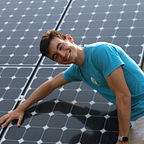Solar energy covers just 1% of the world’s energy needs. Here’s why it’ll cover 100% in 50 years.
And it’ll do it without subsidies.
The Past
In 1990, the year I was born, solar energy was a pipe dream. It was a fun science experiment, and the subject of one or two hippie rants. Nobody ever dreamed of powering their home with solar power back then. If one had been hard-pressed to try, it would have cost somewhere between $200k and $300k for a typical home. Needless to say, there were no solar powered homes back in 1990.
Luckily, there were certain use cases where solar energy was cost-effective and showed promise. Remote regions, small traffic lights, satellites, and calculators.
Governments didn’t stop sponsoring research, and the technology kept evolving little by little. By 2002, there were already 15 different solar photovoltaic technologies fighting for the limelight.
The real gamechanger came somewhere between 2008 and 2010, when exponential growth in solar energy deployments led to a 3-fold reduction in component pricing, and solar energy finally showed it’s revolutionary promise.
The Present
If a picture says 1000 words, then this graph shows 1000 pictures. It shows the mind-boggling power of humanity’s manufacturing power. Today, our solar panels are 200 times cheaper than they were 40 years ago. Solar energy is now economically viable for mass deployment by utility companies, businesses, and homeowners across the world.
There is no indication that this trend will stop. Solar energy is a power source that requires little to no maintenance. It involves no moving parts, and doesn’t need oil changes or fuel (apart from sunlight of course). When a solar panel is deployed, it’ll generate power for 40–50 years if left untouched. This is why solar will take over humanity’s energy addiction.
The Missing Piece
Ah yes, the sun doesn’t shine at night. This has made a lot of people very angry and been widely regarded as a bad move. For solar energy to truly take over all our energy needs, we need a way to store it safely so we can use it when we want, not just when the sun’s out.
Lithium Ion batteries were first used by Sony in 1991 to power small electronics like the Walkman. Today, Li-ion batteries power the Tesla Model S, which does 0–60 in 2.5 seconds. There are many companies betting on the fact that these same batteries will also hold the bulk of the solar energy we’ll use at night. It’s likely that these batteries will enter a growth curve similar to the one experienced by solar panels, which will cause a significant reduction in price.
Elon claims that by Tesla’s calculations, we need about 100 of these factories to supply Earth with the batteries it needs to go fully renewable. I wouldn’t bet against a guy like Elon.
The Future
By the year 2067, four things will have happened that will make any energy that isn’t solar completely obsolete.
- Human-caused climate change will not be debated in any societal circle, and we’ll look back at today’s times with a collective frown as we realize how much time we wasted by not slowing down our CO2 emissions earlier.
- Solar and battery costs will have plummeted, making solar energy 10–20 times cheaper than the next cheapest source of energy.
- All solar deployment will be automated, so no human interaction will be needed from the moment the silicon is mined, to the moment a solar farm is built and connected to the grid.
- The only power sources that will have lasted till then, without any maintenace whatsoever, will be solar panels.
I have nothing against wind or hydroelectric power, I just don’t think they’ll be price-competitive with solar very soon.
I try to imagine what it was like to research solar cells 50 years ago, and I hope some of those scientists are still alive to witness the revolution they kindled. Everyone who invests their time, energy, or money into solar today is just as important. We are still under 1% of our energy needs. Our work is just beginning.
